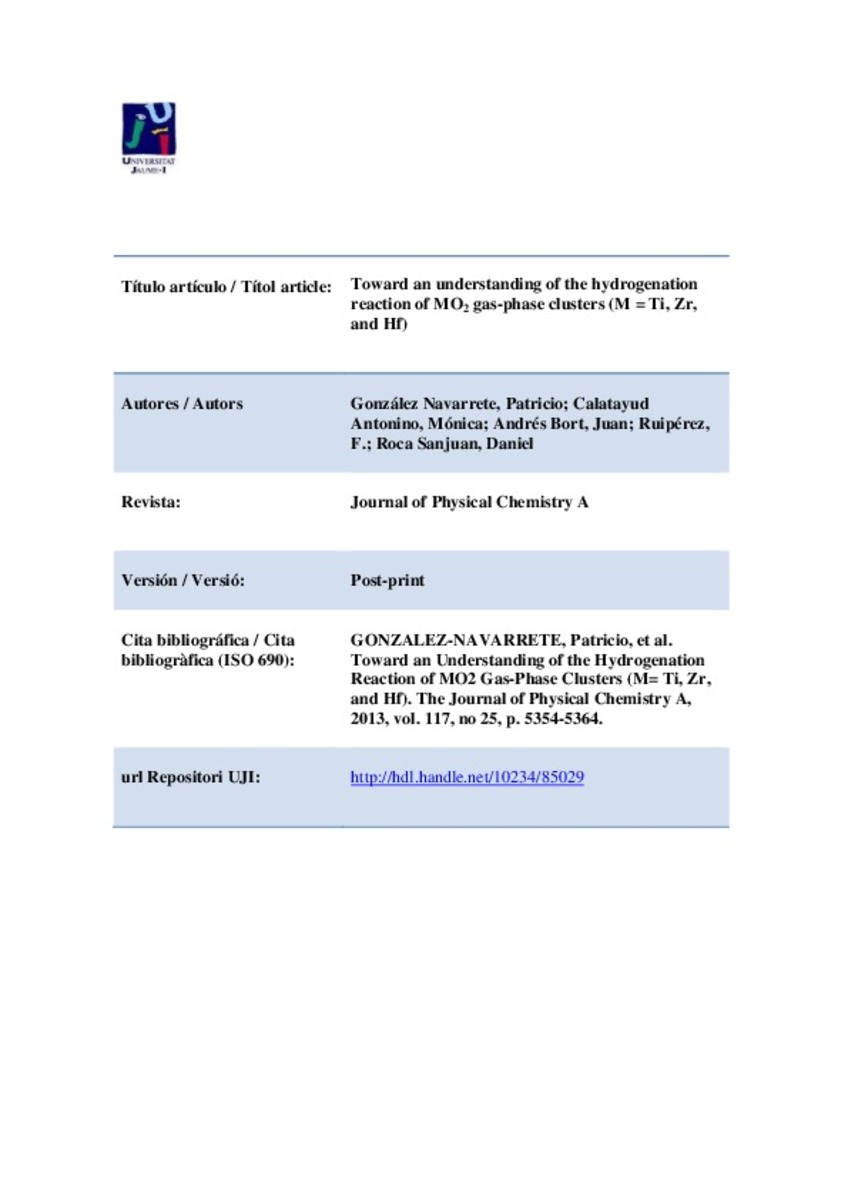Mostrar el registro sencillo del ítem
Toward an Understanding of the Hydrogenation Reaction of MO2 Gas-Phase Clusters (M = Ti, Zr, and Hf)
| dc.contributor.author | González Navarrete, Patricio | |
| dc.contributor.author | Calatayud Antonino, Mónica | |
| dc.contributor.author | Andres, Juan | |
| dc.contributor.author | Ruipérez, F. | |
| dc.contributor.author | Roca Sanjuan, Daniel | |
| dc.date.accessioned | 2014-03-03T08:40:46Z | |
| dc.date.available | 2014-03-03T08:40:46Z | |
| dc.date.issued | 2013 | |
| dc.identifier.citation | GONZALEZ-NAVARRETE, Patricio, et al. Toward an Understanding of the Hydrogenation Reaction of MO2 Gas-Phase Clusters (M= Ti, Zr, and Hf). The Journal of Physical Chemistry A, 2013, vol. 117, no 25, p. 5354-5364. | ca_CA |
| dc.identifier.issn | 1089-5639 | |
| dc.identifier.issn | 1520-5215 | |
| dc.identifier.uri | http://hdl.handle.net/10234/85029 | |
| dc.description.abstract | A theoretical investigation using density functional theory (DFT) has been carried out in order to understand the molecular mechanism of dihydrogen activation by means of transition metal dioxides MO2 (M = Ti, Zr, and Hf) according to the following reaction: MO2 + H-2 -> MO + H2O. B3LYP/6-311++G(2df,2pd)/SDD methodology was employed considering two possible reaction pathways. As the first step hydrogen activation by M=O bonds yields to metal-oxo hydride intermediates O=MH(OH). This process is spontaneous for all metal dioxides, and the stability of the O=MH(OH) species depends on the transition metal center. Subsequently, the reaction mechanism splits into two paths: the first one takes place passing through the M(OH)(2) intermediates yielding to products, whereas the second one corresponds to direct formation of the product complex OM(H2O). A two-state reactivity mechanism was found for the TiO2 system, whereas for ZrO2 and HfO2 no spin-crossing processes were observed. This is confirmed by CASSCF/CASPT2 calculations for ZrO2 that lead to the correct ordering of electronic states not found by DFT. The results obtained in the present paper for MO2 molecules are consistent with the observed reactivity on surfaces. | ca_CA |
| dc.description.sponsorShip | Financial support from the Ministerio de Ciencia e Innovación (MICINN) for projects CTQ2009-14541-C02 and CTQ2010-14892 and Generalitat Valenciana for Prometeo/2009/053 project is gratefully acknowledged. The authors are also grateful to the Servei d’Informatica, Universitat Jaume I, DSI-CCRE and GENCI-IDRIS (grants x2010082131, x201108213, and x2012082131) for computational facilities. P.G.-N. thanks the HPC-EUROPA2 project (project no. 228398) for support of the European Commission-Capacities Area-Research Infrastructures. F.R. thanks the Eusko Jaurlaritza (GIC 07/85 IT-330-07) for financial support and the Spanish Office for Scientific Research (CTQ2011-27374). The SGI/IZO-SGIker UPV/EHU is gratefully acknowledged for generous allocation of computational resources. | |
| dc.format.extent | 11 P. | ca_CA |
| dc.language.iso | eng | ca_CA |
| dc.publisher | American Chemical Society | ca_CA |
| dc.relation.isPartOf | The Journal of Physical Chemistry A, 2013, vol. 117, no 25 | ca_CA |
| dc.rights | Copyright © 2013 American Chemical Society | ca_CA |
| dc.rights.uri | http://rightsstatements.org/vocab/InC/1.0/ | * |
| dc.subject | Transition-metal cations | ca_CA |
| dc.subject | Matrix-isolation FTIR | ca_CA |
| dc.subject | Electronic-structure | ca_CA |
| dc.subject | Ab-initio | ca_CA |
| dc.subject | Molecular-structures | ca_CA |
| dc.subject | Perturbation-theory | ca_CA |
| dc.subject | Dihydrogen activation | ca_CA |
| dc.subject | Selective oxidation | ca_CA |
| dc.subject | 2-state reactivity | ca_CA |
| dc.subject | Titanium-dioxide | ca_CA |
| dc.title | Toward an Understanding of the Hydrogenation Reaction of MO2 Gas-Phase Clusters (M = Ti, Zr, and Hf) | ca_CA |
| dc.type | info:eu-repo/semantics/article | ca_CA |
| dc.identifier.doi | http://dx.doi.org/10.1021/jz300974v | |
| dc.rights.accessRights | info:eu-repo/semantics/openAccess | ca_CA |
| dc.relation.publisherVersion | http://pubs.acs.org/doi/ipdf/10.1021/jp4033589 | ca_CA |
| dc.type.version | info:eu-repo/semantics/acceptedVersion | ca_CA |
Ficheros en el ítem
Este ítem aparece en la(s) siguiente(s) colección(ones)
-
QFA_Articles [819]
Articles de publicacions periòdiques







